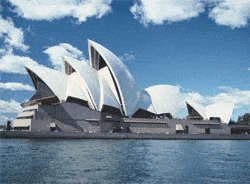AUSTRALIA

| |
|
Australia has traditionally prided itself on being the lucky country. The tag seems rather apt just now. The economy has expanded for well over a decade, and the majority of middle-class Australia has a thicker waistline to show for it. But is the country in for a rather uncomfortable bout of indigestion? That depends on whether the drivers of growth are bubble or brawn.
The fundamentals look positive, if a little heated. GDP growth was more than 3% per year in the first quarter of the year and is likely to stay that way for the next year or two, according to Commonwealth Bank of Australia (CBA) research. Meanwhile, unemployment is hovering around the 5% mark, having broken a new record of 4.9% in May, which represented a three-decade low. This means employers are chasing suitable employees, which in turn is lifting wages. Thats fortunate for the average Australian who is concerned about the federal governments industrial relations reforms. Introduced earlier this year, the laws give businesses greater powers to hire and fire their workers under individually negotiated workplace agreements.
Australians are showing little concern for their economic security, however. Retail sales continue to grow, partly due to expansive personal income tax cuts, which came into effect on July 1. A strong Australian dollar also helps to make the countrys citizens feel wealthier. The domestic currency has gained 50% against the US dollar in the past five years. This means imports are outpacing exports as Australians buy up all the latest electronics on offer from overseas.
There are other costs, however: It also meant Australias volume trade deficit was A$12.7 billion ($9.5 billion) in the first quarter of this yearthe worst on record, points out Tony Pearson, head of Australian economics at Australia and New Zealand Banking Group (ANZ), in his July report.
However, the only cloud on the horizon for the average household is the prospect of another interest rate rise. That could hurt: Australians love debt as much as Americans do, and when combined with a penchant for owning their own property, it gives them one of the highest debt-to-income ratios in the world. As senator Lyn Allison recently pointed out, household debt has grown by a monstrous 221% in the past decade to A$927 billion. With interest rates at 5.75%, that means the average Australian is spending about $11 on every $100 they earn to pay back interest on their debt.
There are also concerns that house prices might not be sustainable, having almost doubled in most capital cities over the past decade. But this may amount to a soft landing only. While in Western Australia and Queensland house prices continue to surge, riding high on the back of the resources boom, New South Wales and Victoria have seen a prolonged slump over the past few years. Although the CBA points to a lift in building approvals and first homeowner approvals, ANZs Pearson says the market will be soft going forward.
Underpinning the buoyant economy of the past few years is a booming resources sector. This is driven largely by demand from the growing economies of China and India. According to ANZs Pearson, high commodity prices and high terms of trade have substantially lifted domestic income. It has also meant the Australian Stock Exchange has risen to dizzying new heights. The S&P;/ASX 200 index first passed the 4000 mark in late 2004 and went on to break the 5000 mark in March this yearposting a gain of 796.4 points in the past financial year, up 18.6% to 5073.9.
The market lost some of its luster in May and June when fears of high global interest rates and slower economic growth resulted in several weeks of volatility. Metals such as gold, zinc, aluminum and copper were hit particularly hard, falling around 20%-30%. Most view the sell-off as a correction rather than a downturn. In fact, a large number of economists around the world expect the boom in resources to continue for at least another decade.

|
While the market will be strong, prices might not hold at current levels. BHP and Rio Tinto secured an additional 70% on the price of iron ore last year, but according to recent media reports the Chinese government is preventing its steel makers from paying more than $54 per metric ton for iron oreabout $10 less than the asking price. Notes Deutsche Banks head of mergers and acquisitions, Mike Roche, based in Sydney, Theyre getting sick of fronting up to BHP and Rio Tinto and Brazils [Companhia Vale do Rio Doce], which are demanding big price increases. He believes China will seek to secure supply from other sources through strategic stakes in companies that in turn have a stake in a project.
In the meantime, Australias resources companies are not sitting idle. Mining companies OneSteel and Smorgon Steel Group are planning a $5.5 billion merger, and theres talk of other smaller players joining forces. There will be a lot of consolidation among second-tier playersmostly domestic, Roche says. However, it remains a local play: I think international interest will not really step up until some of these happen so that it gets to a meaningful size.
Buying Big
One of Australias probloems, which is becoming more acute in an increasingly global market, is its tiny economy. This is driving consolidation, resulting in $100 billion of deals over the past 12 months. One of the highlights of last financial year was the hostile takeover by Australias largest freight company, Toll Holdings, of the countrys largest port operator, Patrick Corp. Initially valued at about A$4 billion, Patrick eventually sold for about A$6 billion.
There are few acquisition opportunities in Australia for overseas companies, however. Thats due in part to the high local share prices. But private equity is taking an interest in the region, and investment may take off over the next few years, according to Roche. Last year, buyout funds landed more than A$1 billion in deals, including Kohlberg Kravis Roberts acquisition of Brambles Industries waste management assets and TPG-Newbridge Capitals purchase of the Myer department store business.
Roche points to the fact that private equity bids have only narrowly missed out on a couple of large assets. Its an amazing outcome, given the stock market is so high, he says. If the stock market falls, he adds, it will be interesting to see what happens to their competitiveness: It will depend on the extent to which the debt markets retreat, as leverage is driving a lot of the capacity at present.
Home Sweet Home
Much of Australias strength is as an exporter of capital, predominantly in the property and infrastructure sectors. The biggest driver here is the countrys compulsory superannuation scheme, which ensures 10% of contributions are invested in property and an increasingly large portion in alternative assets like infrastructure.
Australia is very active in the real estate investment trust (REIT) space, being the most securitized property market in the world. While Australians are looking for further investment opportunities in the US, Europe and Japan, overseas counterparts have their hopes set on the buoyant Australian market. But theyre destined to fail, says Roche: People would like a piece of their portfolio in Australian property, but every domestic player is already there.
Australia is also a dominant force in global infrastructure. Limited investment opportunities at home are dwarfed by an increasing appetite for assets. Challenger Financial Services head of infrastructure, Steve Bickerton, based in Sydney, says, Theres a huge amount of demand from investors for opportunities to invest in infrastructure assets. But he says there isnt the depth in Australia: Its more and more attractive to go overseas because of the shortage of opportunities here. Theres also better value [in other countries].
Governments around the world are balking at putting money into infrastructure, and the private sector is the direct beneficiary, picking up assets including airports, toll roads and electricity. Every man and his dog is opening an infrastructure fund. All the US investment banks are, Deutsche Banks Roche observes. However, Australia boasts a mature infrastructure market and is a predominant player overseas, he says: Its not uncommon, if there are four to five bidders offshore, that four of them will be Australian. Macquarie Bank leads the field here, buying up assets in the US, Canada, Europe and Asia. Despite the sharp increase in infrastructure funds, it continues to enjoy its success as others play catch-up.
The traffic is not all one way, however. Notably, the government is considering an overhaul of the countrys cross-media laws at present, which, if accepted, will lift restrictions on foreign ownership. If it gets through the parliamentary process unscathed, the legislation will provide significant opportunities for offshore players.
|
WHOS WHO IN AUSTRALIAN FINANCE |
|
Prime Minister John Howard There doesnt appear to be any stopping Prime Minister John Howard, leader of the Liberal Party. Despite a number of incidents during his years in office that made him appear less than upfront, he maintains a strong following among Australiansdue in large part to the fact that he has led the country through more than a decade of economic growth. An election is due in 2007, and it is unlikely he will run for a fifth term, but no one can rule it out completely.
|
Resource Squeeze
Fiona Haddock



